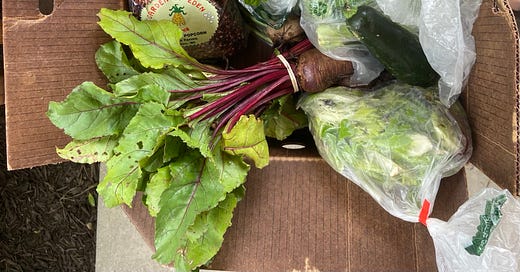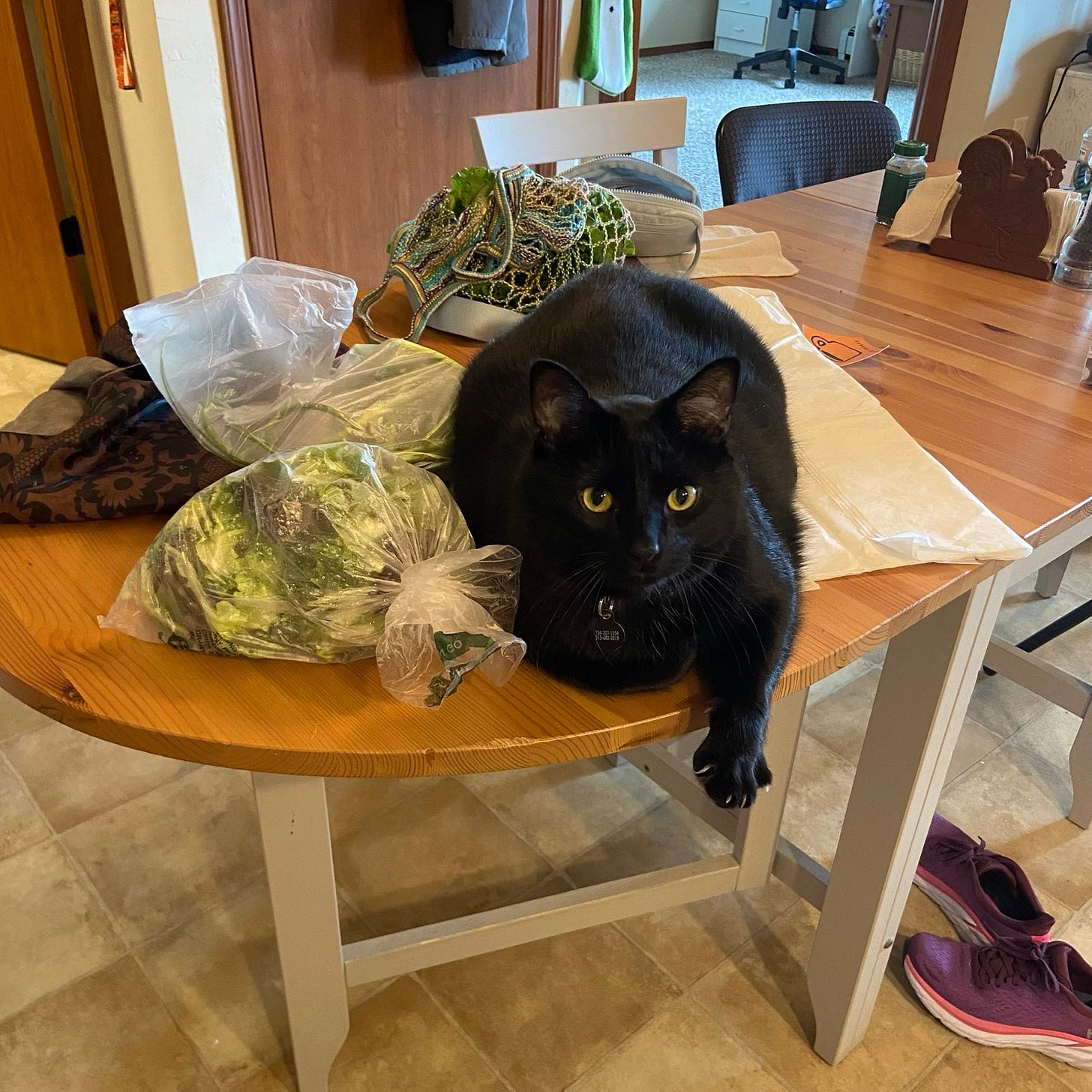Who's Your Farmer?
I didn't think I could appreciate food more than I already do. Then I bought a farm share.
Last Monday, my kitchen looked like a murder scene. A knife rested on my cutting board, glistening with shiny, red liquid that stained everything. I tried not to touch any surfaces with my reddened fingertips as I walked over to the sink, which looked like a tub where a small animal had just been slaughtered.
No animals were harmed in the making of this mess, though. I was just learning how to cook beets for the first time.
I learned that the best way to get them out of their tough skins is to wrap each beet in tinfoil like a potato and cook them in the oven for an hour. Then, once they’re cool enough to touch, you can peel the skins right off under some cold water.
So there I was, taking each beet over to my sink and removing their outer layers like the shell of a hard boiled egg. Then, I carried each skinless, bright red ball back to the cutting board, where I diced it into half-moon shapes and place it on a plate. Everything those beets touched turned red. It’s such a brilliant color in person, albeit a little jarring if you’ve just walked into the kitchen with zero context.
My beet rendezvous wouldn’t have happened without my community-supported agriculture (CSA) share from a local farm. Every week, my farmers, who live about 30 minutes away from me, pick a selection of veggies and other crops growing on their land and send them to me in a neatly-packed box. Some weeks I end up with produce that I’ve never cooked before — like beets.
If you aren’t familiar with CSAs, they’re kind of like getting the farmer’s market delivered to your door. They’re one of (if not the) most direct ways to support the people around you that grow food for a living. In the process, you get a regular delivery of really, really fresh produce and whatever else your farmers happen to make/grow/offer.
And they’re not just a Wisconsin thing, or a rural thing. Pretty much everywhere in the U.S. has some kind of farm that offers a CSA share.
Seriously, just go to Google and type in the place you live + "CSA” or “farm share.” I can almost guarantee you’ll find something near you, whether you live in a major city or a small town. (Local Harvest is also a good place to start if you’re looking, and some regions have state-specific CSA websites, like the Michigan CSA Network).
This year was the first where I’ve signed up for a farm share, and so far I love it. I want everyone to do this, because I think it’s such an awesome way to support local, small farms and really up your food game. So if you’re reading this essay and thinking, Jenn, this just sounds like an advertisement for CSA shares???, you’re kind of right. But I think I have a few damn good reasons for wanting everyone else to appreciate them, too.
The biggest and most glaring thing for me is that buying produce directly from a local farm allows me to divert a decent chunk of my grocery budget away from big box stores. Ryan and I mostly shop at Aldi, which certainly isn’t the worst choice for a grocery store. I like that Aldi is more focused on environmental sustainability than other stores, and I do frequently see produce in their aisles that come from the region we live in.
But at the end of the day, Aldi is still a massive supermarket chain. It might be a decent one that shares some of my values, but their main interests aren’t in making my corner of the world a better place. A supermarket isn’t about community or helping me get more in touch with the food I eat and where it comes from. It exists to make money.
My CSA farm, on the other hand, is already part of my community — I just didn’t know they were there until I went looking for them. I learned that they host events like pizza night on the farm, and they have an online store where you can buy goods like jams and popcorn from other farms in the area. They also make money, of course, but their existence feels more purposeful. And I can tell the folks who run the farm really, really believe in what they do.
Plus, I love to see how much food we can make right here in our own backyard. Big grocery stores frequently ship in produce that was grown hundreds of miles away, which has led many of us to forget what food even comes from the regions we live in.
Isn’t it wild that I can buy a bag of apples from Washington or a carton of strawberries from Mexico that traveled over a thousand miles to get to a grocery store in the Midwest? We barely even think twice about it when we’re loading those fruits and veggies into our carts.
Imagine all the people who handled that produce, from planting to picking to packing it. Plus the time it spent being moved from trucks and trains and airplanes. We really do take these things for granted. And I, like many Americans, often forget the time, energy, and skill that goes into farming.
Signing up for a CSA share this year made me realize how little I know about the food that’s grown in Wisconsin. Sure, everyone knows we’re the dairy state. And maybe you’ve also heard about Door County cherries or our legendary cranberry bogs.
But what about other fruits and veggies? The unremarkable-but-necessary stuff like lettuce, garlic, and tomatoes? Different produce grows at different times of year, but I’m just not in-tune with the seasons enough to know when to expect certain foods. I can say that my CSA is quickly teaching me about it all.
One of my first produce boxes had rhubarb in it, which is a vegetable I wasn’t well-acquainted with. I thought it was celery when I first saw it. But rhubarb is a little more dense and less crispy than celery, so I knew the consistency wasn’t right — plus I found myself wondering why I’d never seen red celery before.
I started to feel a little out of my element, having this vegetable I could barely identify and had no idea how to cook. I’d had rhubarb cakes and rhubarb lemonade before, but didn’t know how to make them, so I went online to find some recipes.
Ryan and I settled on a rhubarb cake that ended up tasting like a sweet, tangy dream. And after surmounting the challenge of making something new with a new-to-me veggie, I have to admit I was quite proud of myself.
If you like to cook, CSA boxes are one of the best ways to challenge yourself and make a super nutritious meal. However, if you’re not much of a cook, a lot of farm share programs allow some level of customization, so you won’t always have to get stuff that you don’t know how to use. For my CSA, I’m allowed to choose 2-3 items per week from a list of options and then the farmers give me a few more things they have a surplus of.
Also, you can always split a share with a friend! I’ve known several people who do this, and it’s a great way to make sure you’re not taking home too much stuff that you won’t use.
Oh, and you might be wondering how much a CSA costs. In my experience, they’re actually quite affordable (considering the price of groceries at the moment). I paid $360 for 18-20 weeks of produce, depending on how the growing season goes. That’s $18-$20 per week, which is around what I’d probably spend if I bought the same amount of stuff at the grocery store.
The other week I got a big bunch of swiss chard, garlic scapes, beets, salad mix, several medium-sized zucchinis, and broccoli. It might be sliiiightly cheaper to buy some of those things at the grocery store, but to me the CSA price seems pretty dang reasonable. The portions are generous and I get a lot of variety through the season, which is part of what I’m paying for.
I also don’t mind if I’m paying a little more because I know the farmers get 100% of those funds. And I know that local produce has more nutritional value than the stuff at the store because it is fresher and doesn’t travel as far to get to me.
The best part of my CSA is that it makes ordinary food seem exciting. I love getting my box every week because I get new veggies to try and I know they’ll always taste amazing.
I also find that I’m less nonchalant about wasting food. Getting a hand-picked box of produce every week reminds me that someone worked really, really hard to make sure their crops grew so that they could feed me. The least I can do is take some time out of my week to make a nice salad, soup, or a stir fry that puts those precious veggies to good use. My body — and the Earth — will thank me for it.
Come write with me this Saturday, July 27!
I’m teaching a VIRTUAL workshop called The 60-Minute Memoir, which will be hosted thru WordHaven Bookhouse in Sheboygan, Wisconsin.
We’ll hang out and brainstorm some ideas for your own shortform memoirs/personal essays (like the ones you read here)! We’ll also discuss strategies for writing when you hit writer’s block or don’t have a lot of time to write.
Honestly, most of the essays I write for this newsletter are done in about an hour or so, and that’s what helps me consistently write despite my busy schedule. So if you want to write more about your experiences but need help doing it in a timely fashion, this class is for you.
Even if writing fast isn’t your thing, you’ll leave class with some personalized prompts for your next essay. Class is $10 per person, and proceeds directly benefit me and WordHaven.
Click here to sign up! We’ll meet at 1pm CT on the 27th. I’ll send you a meeting over email.
If you enjoyed this post, consider dropping a donation in my tip jar on Ko-fi!
This newsletter will always be free to read and share, but I rely on the generous donations of readers to build financial security and keep this project going long-term.
Huge shoutout to my 2024 supporters:
Dennis T.
KRW
Grandma Gin Gin
Tara Y.
Murphy Kaye
Maddie B.
Mom
Emma H.
Molly G.
❤️❤️❤️




